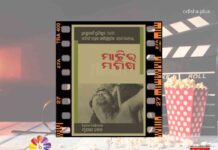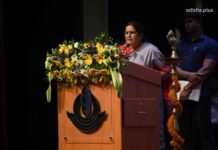Sambeet Dash
The month of June is regarded as the beginning of summer in USA, whereas in Odisha, my home state in India, it marks the beginning of the end of the blistering, hot summer season. Raja Sankranti is a prevalent popular festival of this time of the year – especially in the long, rich Coastal Odisha arriving at mid June per the Gregorian calendar.
 It is also considered as the harbinger of the cooler rainy season, as the South West monsoon rolls over the state from the North East, lashing it with silvery stripes of rain and garlanding its nimbus cloud bearing dark sky with flashes of white lightening like zillions of flashlights in sky. It brings the much needed relief from long streak of heat and prickly humidity, healing the parched earth dried from a long Indian summer.
It is also considered as the harbinger of the cooler rainy season, as the South West monsoon rolls over the state from the North East, lashing it with silvery stripes of rain and garlanding its nimbus cloud bearing dark sky with flashes of white lightening like zillions of flashlights in sky. It brings the much needed relief from long streak of heat and prickly humidity, healing the parched earth dried from a long Indian summer.
As the silvery monsoon rains ornament the thick humid air, the perfume of PODA PITHA (baked rice cake) pervades the environment. Young and old alike play on DOLI (swings), with men snarling their blackened teeth and girls exposing red pouty lips – post effect from chewing PAAN (betel leaves filled with colored condiments).

The drenched earth, now softened by the rains gets ready for tilling, marking the beginning of the farming season when water supply gets plenty from fresh monsoon rain. I still cherish memories of trips to my ancestral village for a fun filled lunch of GHEE (clarified butter) laced NADIA KHECHUDI (coconut sprinkes sweet rice), thick DAAL (Lentil soup), an array of Curries and fries, usually KHIRI (sweetened skimmed milk) – followed by an afternoon session on the swing.
Dinner would be PITHA (Rice cakes) and more varieties of PITHA – the icing on the cake would be occasional PODA PITHA made from ripened TAALA, fruit from tall palm trees, as a fitting finale to a day of RAJA MAUJA (fun).

I remember the tall palm tree in right behind our home facing a pond perennially covered with a cessful of watercress in its dark, stenchful barely visible water where locals wash their bottoms. During the early monsoon close to Raja festival these large brownish – black color Palm fruits with a yellowish orange pulp ripen and fall off. Many roll into the green swamp. Those who survive make their way to PODA PITHA of another flavor. Sad to hear that palm tree ruptured from its middle as it couldn’t withstand the devastation from last month’s Cyclone Fani.
A few summers ago in Odisha, on the morning of RAJA Festival I switched on the TV. A promotional song LEMBU, ATI CHUPUDILE PITA (Excessively squeezed lemon taste bitter) from an Odia movie scheduled for the RAJA release was playing in background as an Odia actress, dancing to the tune of a song from that movie was being interviewed.
It didn’t go unnoticed to me that a discussion about an Odia movie, between an Odia anchor and an Odia leading actress getting released on a leading Odia festival, was taking place with a typical accented Odia with almost an equitable spread of 50% Odia, 30% English and 20% Hindi. A lot of billboards and commercials on local newspapers took pride in pronouncing RAJO instead of RAJA.
A person usually speaks with an accent when speaking a language other than the mother tongue. Odisha is perhaps the only place on earth, where many not only love to speak their own mother tongue with an accent, also chose to write it in another accent – RAJA as RAJO stands testimony of that. Wish you a Happy RAJA from the bottom of my heart. Have fill of RAJA MAUJA.


























Very nicely written. Raja as pointed out by the writer marks the beginning of monsoon. With weather conditions undergoing a dramatic change the humidity and the heat are their while we still await the rains. Mostly observed as a festival for the maidens.